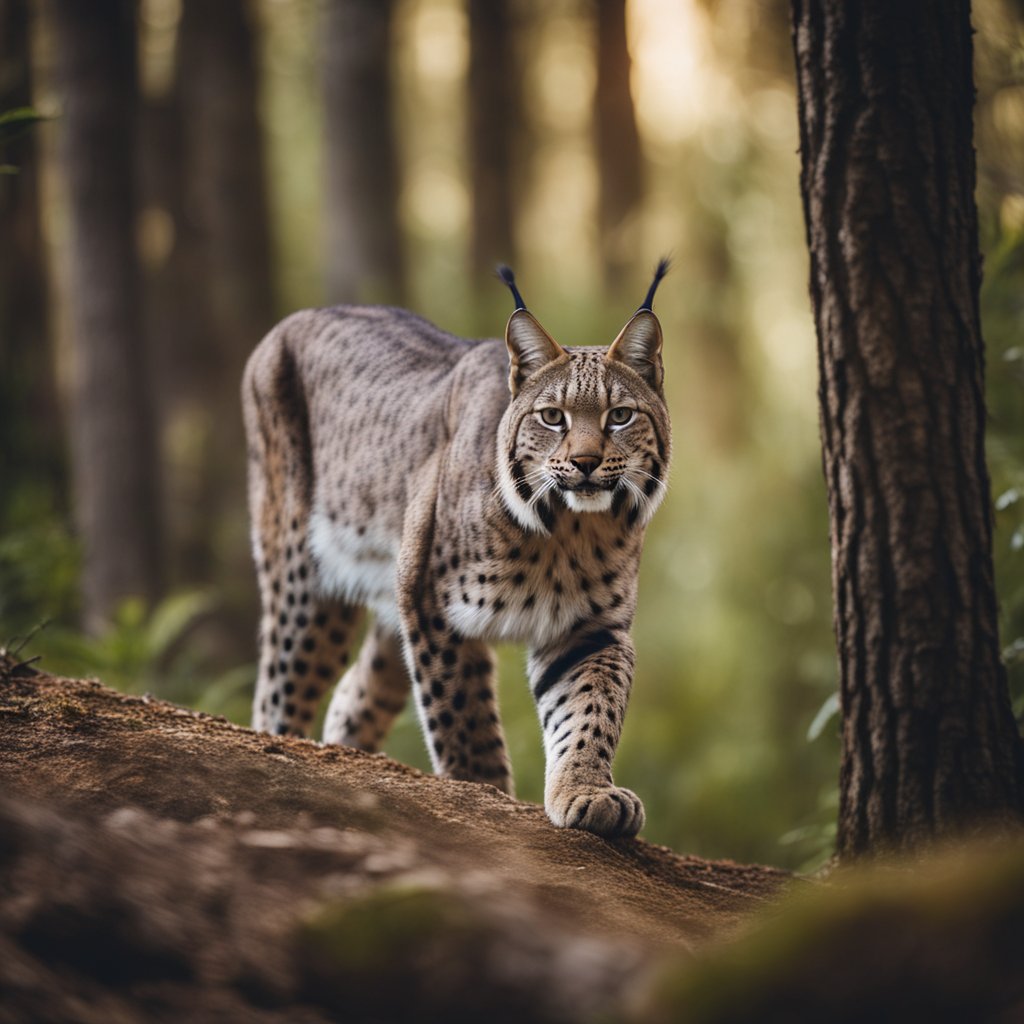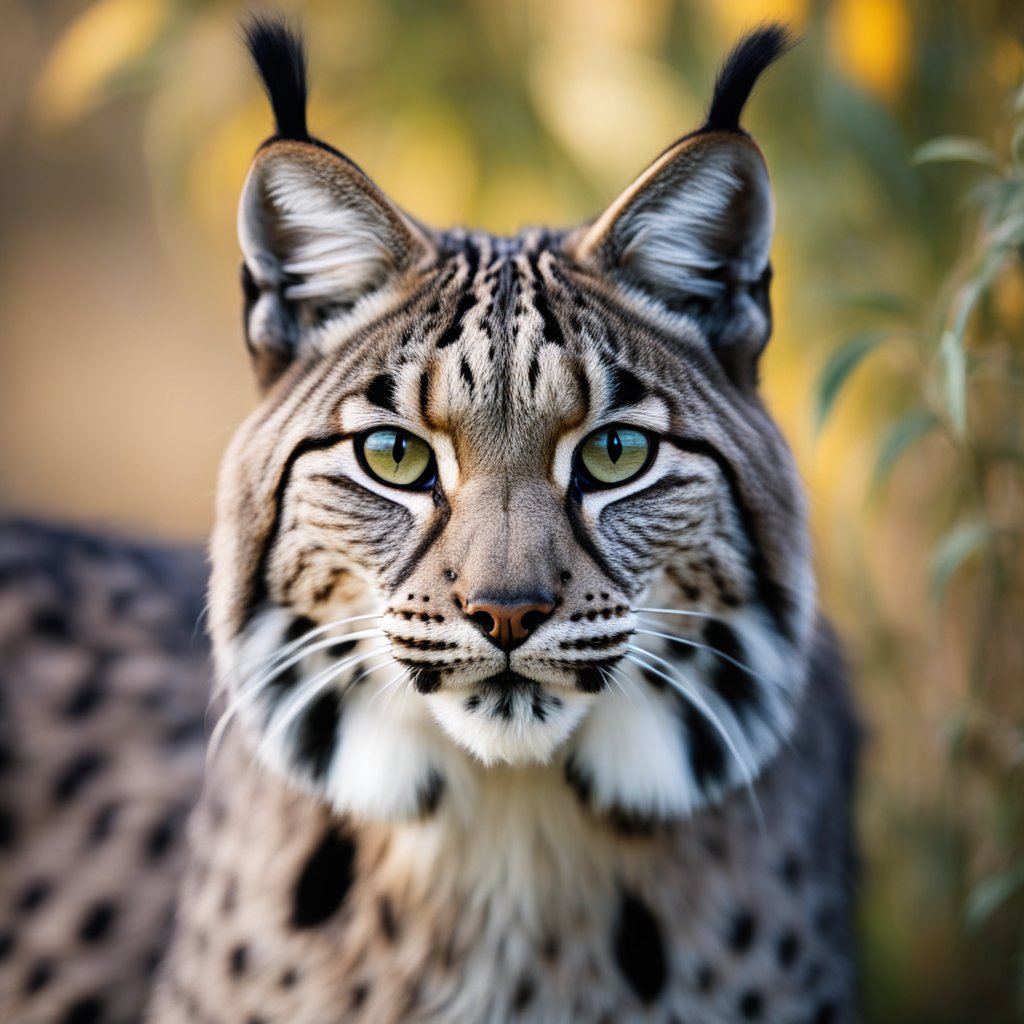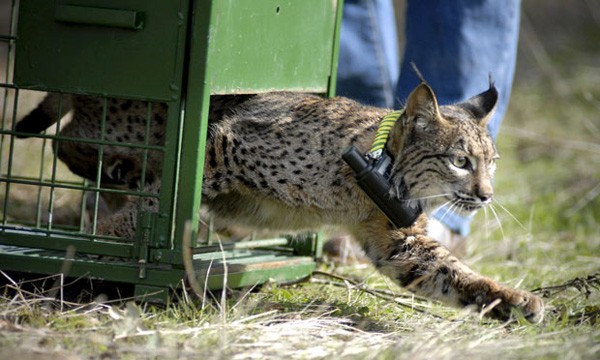
Iberian Lynx: Conservation Efforts and Population Recovery
The Iberian lynx, or Lynx pardinus, is a critically endangered wild cat species native to the Iberian Peninsula, which includes Spain, Portugal, and their surrounding regions. Known for its distinctive tufted ears and spotted coat, this elusive feline is one of the rarest and most unique wild cats found in Europe. The Iberian lynx is a close relative of the more widespread Eurasian lynx, but it is smaller in size and has a slightly different appearance.
Its habitat mainly consists of Mediterranean scrublands, where it blends in well with the surrounding environment and initiates its stealthy hunting techniques. The primary prey of the Iberian lynx is the European rabbit, but it can occasionally adapt its diet to other small mammals and birds, depending on the availability of prey. The species’ life cycle includes a gestation period of about two months, after which a litter of two to four kittens is born. These young lynxes typically stay with their mother for about one year before venturing off on their own.
Key Takeaways
- The Iberian lynx is a critically endangered wild cat native to the Iberian Peninsula, with a distinctive appearance and unique behavior.
- Its primary habitat is Mediterranean scrublands, and it mainly preys on European rabbits, though it can adapt to other prey if needed.
- The life cycle of the Iberian lynx involves a short gestation period and parental care, with young lynxes staying with their mother for around one year before becoming independent.
Species and Description

Appearance and Size
The Iberian lynx (Lynx pardinus) is a medium-sized wild cat species belonging to the Felidae family. Its appearance is characterized by a ruff of fur around its face, giving it a beard-like look, and tufted ears. The coat has a tawny-yellow base color marked with spots that are typically black but can vary in size and shape. The body is equipped with a short tail and powerful limbs that enable quick and agile movements.
The size of an adult cat ranges from 85 to 110 cm (33 to 43 inches) in body length, with a shoulder height of about 60 to 70 cm (24 to 28 inches). Males typically weigh 12.9 to 26.8 kg (28 to 59 lbs), while females average 9.4 to 10 kg (21 to 22 lbs).
Lynx Species Comparison
The Iberian lynx is one of four lynx species, including the Eurasian lynx (Lynx lynx), the Canada lynx (Lynx canadensis), and the bobcat (Lynx rufus). In comparison to its relatives, the Iberian lynx is smaller in size and has a more distinctively spotted coat. Additionally, the Iberian lynx has shorter ear tufts and a less prominent ruff than the Eurasian lynx. The bobcat, on the other hand, has a similar-sized body and coat pattern but is predominantly found in North America.
Unique Traits
As a feline species, the Iberian lynx exhibits several unique traits that make it well-adapted to its environment. Its nocturnal nature and solitary lifestyle provide it with the necessary skills for stalking prey and avoiding potential threats. The tufted ears enhance their sense of hearing, while the ruff provides camouflage while sneaking through the underbrush.
Iberian lynxes are obligate carnivores, with their diet primarily consisting of rabbits. Their instinctive hunting skills and powerful bite force make them efficient predators. The ability to thrive in a variety of habitats, including scrublands and forests, has contributed to their resilience as a species. However, habitat loss and a decrease in rabbit populations have led to the Iberian lynx being classified as a critically endangered species.
IBERIAN LYNX Distribution and Habitat
Geographic Distribution
The Iberian lynx is an endangered species found primarily in the Iberian Peninsula, which includes parts of Andalusia in southern Spain and portions of Portugal. Historically, their distribution extended across Europe and even into Asia. However, habitat destruction and other factors have significantly reduced their range.
Natural Habitats
Iberian lynxes predominantly inhabit Mediterranean woodlands and forests, with a preference for areas consisting of a mosaic of dense shrubs, holm oak, cork oak, strawberry tree, mastic, and juniper. These habitats provide ample cover and food resources, including their main prey, the European rabbit. Two key regions for Iberian lynx populations are the Doñana National Park and the Sierra Morena mountain range, both located in southern Spain.
Home Ranges and Territories
The wild cat’s territories are known to vary depending on factors such as habitat quality, prey availability, and population density. In general, males have larger home ranges than females, which can overlap with the territories of one or more females.
- Doñana National Park: Research in this region indicates that the average home range size for males is about 8.0 km², while for females it’s around 3.0 km².
- Sierra Morena: In this area, the average home range sizes for males and females are 9.4 km² and 4.9 km², respectively.
It is important to note that these home ranges may change seasonally or due to environmental factors, and Iberian lynxes will adjust their range in response to fluctuations in prey availability and habitat quality.
Diet and Predation
Primary Dietary Sources
The Iberian lynx primarily preys on European rabbits (Oryctolagus cuniculus), which constitutes almost the totality of its diet. Although it is a specialist predator, the Iberian lynx also consumes other small mammals such as rodents and birds when rabbit populations are low. In some cases, it may also prey upon larger animals like mouflon and deer but such events are less frequent.
Feeding Habits and Predation
Feeding ecology studies show that the Iberian lynx’s diet is mainly composed of mammals (80.9% of the total occurrences) and, to a lesser extent, birds (19%). This diet can be described as monotonous, focusing heavily on rabbits and small mammals. The consumption of supplementary food, like the amounts provided in conservation efforts, may be modulated by the abundance of the lynx’s wild prey. When the primary prey, European rabbits, are in low numbers, the Iberian lynx adapts by consuming more supplementary food and expanding its diet to include other prey species like rodents and birds.
Intraguild predation is a rare event within the Iberian lynx population. This occurs when an Iberian lynx preys upon another lynx, generally due to territorial disputes or limited food resources. Such incidents may pose a disease risk within the lynx population, and understanding these interactions helps to assess the sanitary status of the Iberian lynx and prevent potential outbreaks.
In summary, the Iberian lynx is a specialist predator with a strong preference for European rabbits. However, it displays adaptability in its diet when rabbit populations are low, feeding on other small mammals and utilizing supplementary food provided by conservation efforts.
IBERIAN LYNX Reproduction and Life Cycle
Mating and Reproduction
The Iberian Lynx has a specific mating season that typically occurs between January and February. During this period, the females become more receptive and are ready for breeding. The male lynx will seek out a female mate and engage in various courting behaviors. These behaviors include vocalizations, scent marking, and physical displays, all aimed at attracting the attention of the potential female mate.
Once a successful mating pair is established, copulation occurs multiple times to ensure the female’s fertilization. The gestation period for the Iberian Lynx is around 60 to 66 days. After this time, the female will give birth to a litter of kittens (usually two to four in number).
Captive breeding programs for the Iberian Lynx have been initiated to bolster their dwindling wild populations. These programs focus on producing offspring with desirable genetic, behavioral, and health traits, ensuring their long-term survival.
Offspring and Growth
Newborn Iberian Lynx kittens are born blind and helpless, relying entirely on their mother’s care. The kittens will remain in a hidden den for the first few weeks of their lives. During this time, the mother will provide them with food, warmth, and protection from potential predators.
As the kittens grow and develop, they will gradually begin to explore their surroundings under the watchful eye of their mother. At around six weeks of age, they will start consuming solid food, primarily consisting of the European rabbit (Oryctolagus cuniculus), the primary prey of the Iberian Lynx. As the kittens transition to solid food, the mother will teach them essential hunting skills.
The Iberian Lynx kittens continue to develop rapidly, reaching maturity at approximately 9 months for females and 12 to 24 months for males. Upon reaching maturity, the juveniles will seek out their territories, eventually dispersing from their birth area. This is a crucial stage in their life cycle, as it directly impacts the species’ overall population dynamics and viability.
In summary, the Iberian Lynx’s reproduction and life cycle involve a seasonal mating period, with kittens born after a relatively short gestation period. The kittens are highly dependent on their mothers during their first few weeks before starting to learn the necessary skills for survival. Captive breeding programs have been initiated to support the ongoing conservation efforts for this endangered species.
IBERIAN LYNX Threats and Conservation
Endangered Status and Threats
The Iberian Lynx is an endangered species, facing numerous threats to its survival. Major threats include habitat loss, fragmentation, illegal hunting, competition, and poaching. Loss of habitat is mainly caused by infrastructure development, such as highways, railways, and dams, which lead to habitat destruction and fragmentation. Furthermore, the species faces competition for resources from other predators in their ecosystems.

Conservation Efforts and Measures
Conservation measures are crucial to prevent the extinction of the Iberian Lynx. The primary focus is on habitat protection, monitoring, and reintroduction efforts. Protected areas have been established to safeguard the species and their habitats. Reintroduction programs involve breeding captive lynxes and releasing them into suitable, protected habitats to increase the wild population. Additionally, monitoring efforts track the Iberian Lynx population to assess the success of conservation measures. Organizations like the IUCN Red List and WWF play a key role in implementing these conservation measures.
Impact of Human Activities
Human activities have a significant impact on the survival of the Iberian Lynx. Habitat destruction from infrastructure development, agriculture, and urbanization is a major concern, as it leads to habitat loss and fragmentation. Illegal hunting, trapping, and poaching also pose threats to the species, as it significantly reduces their population. Conservation measures aim to mitigate these negative effects on the lynx population.
Involvement of Organizations
Various organizations, including the IUCN Red List of Threatened Species and WWF, are actively involved in the conservation of the Iberian Lynx. These organizations provide funding, expertise, and support for conservation measures, such as habitat protection, reintroduction efforts, and monitoring programs. They also collaborate with local communities and governments to ensure the effective implementation of these measures, contributing to the overall recovery of the Iberian Lynx population.
Disease and Population Impact
The Iberian lynx is an endangered species that faces multiple threats, including disease. Disease in both the Iberian lynx and its major prey, rabbits, can have significant impacts on the lynx population.
Lynx and Rabbit Disease
Rabbit populations serve as the primary food source for the Iberian lynx, making the lynx’s survival closely tied to the health of these prey populations. In open pasture and open grassland ecosystems, both myxomatosis and rabbit hemorrhagic disease have caused significant declines in rabbit populations. These diseases not only affect rabbits, but also indirectly impact the Iberian lynx population due to reduced prey availability.
In addition to the indirect effects of rabbit diseases, the Iberian lynx also faces direct threats from various infectious agents. For example, one study has found that Toxoplasma gondii and feline panleukopenia virus (FPV) can cause serious health issues in lynxes, such as high mortality rates in kittens. While the impacts of other disease agents such as feline herpesvirus (FHV) and feline calicivirus (FCV) on the Iberian lynx are currently unknown, they still warrant attention from researchers and conservationists to ensure the long-term survival of the species.
Monitoring and managing disease in both the Iberian lynx and rabbit populations is crucial for the successful reintroduction and conservation of the lynx in its natural habitat. By understanding the complex interplay between these two species and the diseases they face, researchers can work to implement strategies that protect both the lynx and their rabbit prey, ultimately supporting healthier ecosystems for all species involved.
Frequently Asked Questions
What are the main adaptations of the Iberian Lynx?
The Iberian Lynx has several adaptations aiding its survival. It has excellent eyesight, which enables them to spot prey from a distance, and keen hearing to detect nearby animals. Its strong, retractable claws are beneficial for gripping and securing prey, while its muscular body allows for efficient hunting and territorial defense. The lynx’s coat is short and dense, providing protection against the elements and camouflage within its environment.
What does the Iberian Lynx hunt and eat?
The primary prey of the Iberian Lynx is the European rabbit, which makes up the majority of its diet. However, the lynx may also occasionally consume other small mammals, birds, and reptiles when rabbit populations are scarce.
What is the habitat range of the Iberian Lynx?
The Iberian Lynx inhabits the Mediterranean forests of the Iberian Peninsula, primarily in southwestern Spain and Southeastern Portugal. The favored terrain includes dense and well-preserved shrublands where the lynx can find both cover and prey.
What are some unique features of the Iberian Lynx?
The Iberian Lynx is distinguishable by its distinct facial features, such as a beard-like ruff around its face and black tufted ears. Furthermore, its coat is dotted with an intricate pattern of dark spots that provide excellent camouflage in its environment. It is also one of the rarest and smallest wildcats, considered the most endangered cat species globally.
What is the conservation status of the Iberian Lynx?
The Iberian Lynx is currently classified as “Endangered” according to the International Union for Conservation of Nature (IUCN) Red List. This status is the result of habitat fragmentation, a decrease in their primary prey (the European rabbit), and the influence of human activities such as hunting and car accidents.
How do Iberian Lynx raise their young?
Iberian Lynx females usually give birth to a litter of 2 to 4 kittens in spring. The mother raises her young in a den, often located in dense shrub-land, and provides food, protection, and early hunting lessons. The kittens typically become independent around 8 to 10 months, although some may stay with their mothers for over a year before setting off to establish their territories.